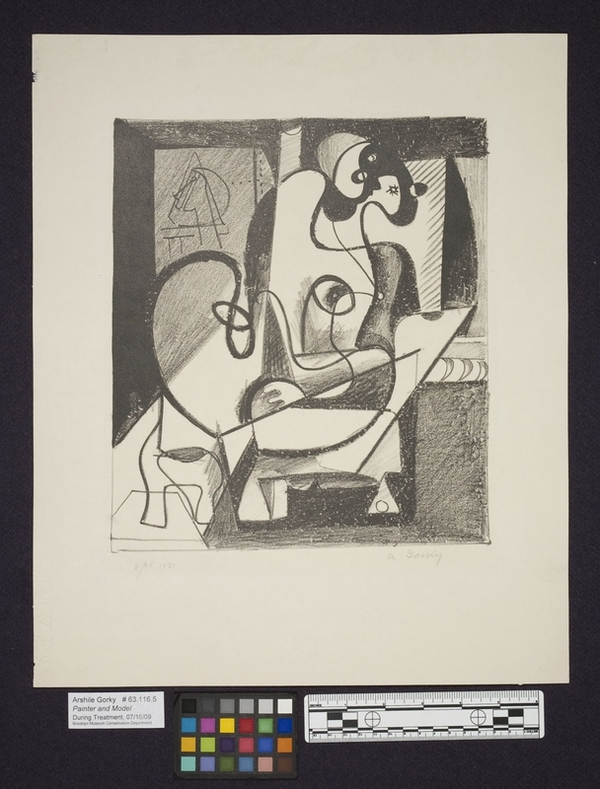Sun Bleaching in the Sculpture Garden
What is the Brooklyn Museum’s important Arshile Gorky lithograph doing outdoors? And why is it immersed in water? I received these questions many times from museum visitors and employees who strolled by my light-bleaching set-up outside the building’s staff entrance on Monday of this week.

It may look like fun-in-the-sun, or an excuse just to work outside, but light-bleaching is in fact, a treatment technique that is employed often by paper conservators and has been a standardized procedure used in the profession of conservation for at least 30 years.
The technique utilizes exposure to light from the sun or from an artificial light source such as fluorescent lamps to reduce discoloration in paper while it is submerged in a bath of purified and buffered water.
Conservators find light-bleaching to be useful because the process is relatively easy to control, the color of the paper appears quite natural after treatment, the paper feels stronger afterward, and the procedure avoids the introduction of another extraneous chemical into an already degraded paper.
Light from the sun is much stronger than that emitted from an artificial source. For this reason the exposure time necessary for good results when sun-bleaching is much less than when light-bleaching indoors. It should be noted however, that while light-bleaching improves the appearance of an object, it does not prolong the life span.

Arshile Gorky (American, born Armenia, 1904-1948). Painter and Model, 1931. Lithograph, Sheet: 11 1/4 x 9 7/8 in. (28.6 x 25.1 cm). Prints, Drawings and Photographs. Dick S. Ramsay Fund, 63.116.5.
Gorky’s Artist and Model is a 1931 crayon lithograph printed with black ink on medium weight, machine made, wove paper. It is scheduled to go out on loan to the Philadelphia Museum of Art this October and so it came to the Paper Conservation Lab for examination.
The print was mostly in good condition except that at some point in its history, animal glue was applied to the front of the sheet just above the image. Over time the glue had become dry and brittle, shrinking and pulling on the paper and resulting in distortion. I carefully removed the adhesive using moisture, revealing a dark brown adhesive stain underneath.

The paper was also discolored in the image area where it was not covered by a mat. This discoloration is the result of overexposure to light over time. Ironically, exposure to light (using controlled aqueous baths) is what can help to reduce this discoloration. In consultation with Eugenie Tsai, the museum’s John and Barbara Vogelstein Curator of Contemporary Art, who agreed that the stains and discoloration were distracting while viewing the image, it was decided that the print would benefit from a light-bleaching treatment.

Many precautions must be taken when light-bleaching. Light-bleaching is an oxidizing reaction catalyzed by the light’s energy in the presence of oxygen. This means that water is an essential component in the light-bleaching process. During its exposure to light, the object is fully immersed in a tray of deionized water.
Also due to the oxidizing reaction that takes place, it is very important to keep the water bath alkaline (at a pH higher than 7) by the addition of calcium hydroxide both during light exposure, and afterwards by rinsing in a second alkaline bath.
Cellulose in paper generally begins to absorb UV radiation at levels below 400 nanometers, which can cause the cellulosic structure of the paper to weaken. For this reason, a sheet of UV filtering Plexiglas is used to eliminate low level radiation by placing it over the tray of water.
This past Monday was a perfectly clear and sunny day. I decided to take advantage of the weather and so I prepared a cart with all of the necessary supplies and rolled it outside. I had pre-rinsed the print in an alkaline bath and carefully transported it on the cart as well. After two hours of carefully monitored exposure during peak sunshine, from 12-2pm, the appearance of the brown adhesive stain at the top of the sheet and the overall discoloration was greatly reduced.

After rinsing the print, I allowed it to flatten while it dried by placing it between blotters under gentle, even pressure. This process eliminated the cockling of the paper caused by the adhesive residue.

Arshile Gorky (American, born Armenia, 1904-1948). Painter and Model, 1931. Lithograph, Sheet: 11 1/4 x 9 7/8 in. (28.6 x 25.1 cm). Prints, Drawings and Photographs. Dick S. Ramsay Fund, 63.116.5.
A few more steps are necessary to complete the full treatment of this piece before it will go out on loan, including mending tears and reinforcing creases, but the light-bleaching portion of the treatment was a success.

Caitlin Jenkins is currently the Andrew W. Mellon Fellow in Paper Conservation at the Brooklyn Museum. She received her M.A. in Art Conservation from Buffalo State College in NY and before coming to the museum she held positions and completed internships in a variety of other conservation labs at institutions including the National Gallery of Art in Washington, D.C., the Northeast Document Conservation Center in Andover, MA, the Ackland Art Museum in Chapel Hill, NC and the Wilson Library, also in Chapel Hill. She received B.A.s in Art History and in Historic Preservation from Mary Washington College.
